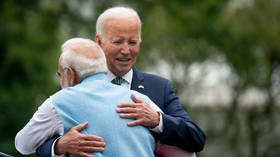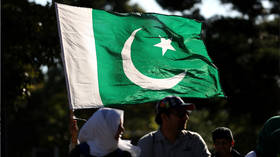India and US agree to end WTO disputes in boost to bilateral trade

India and the US have agreed to end their six trade disputes at the World Trade Organization (WTO) in a bid to boost bilateral commerce and further strengthen economic ties.
The two nations are expected to put in place a strong mechanism to resolve trade-related issues bilaterally to avoid the cumbersome process of filing complaints with the WTO.
India has also agreed to remove retaliatory customs duties on 28 American products, such as almonds, walnuts, apples, among others.
The concessional move comes amid Indian Prime Minister Narendra Modi’s maiden state visit to the US, which concludes on Saturday. The tariffs are likely to be removed in the next 90 days, except the one filed by the US in 2012 regarding India’s poultry trade barriers.
The US, for its part, has removed Indian export subsidies and domestic content requirements for solar cells. However, tariffs on Indian steel and aluminum will remain in place.
In 2018, then-US President Donald Trump slapped duties on steel and aluminum imports, invoking Section 232 of the 1962 Trade Expansion Act and citing national security concerns. India has lifted its tariffs without seeking removal of these Trump-era restrictions.
International trade expert Biswajit Dhar told the Indian wire service Press Trust of India (PTI) that the “positive announcement” would help in promoting bilateral trade between the two countries.
“We now have to see what trade-offs happen between the countries to finally end these trade disputes. The announcement overall looks positive. A strong mechanism needs to be put in place so that such disputes do not occur and be resolved bilaterally through mutually agreed solutions,” he said.
Ajay Sahai, director-general of Federation of Indian Export Organisations (FIEO), also welcomed the resolution of the trade dispute as the US is India’s largest trading partner. Bilateral trade currently totals over $190 billion a year.
“It is a positive development. We were eagerly waiting for this decision. This will give a fillip to India's exports to the US,” he told PTI.
The six disputes comprise three initiated by each country.
Since 1948, trade among market economies has been solely governed by the General Agreement on Tariffs and Trade (GATT), which set certain ground rules for tariffs and trade. In 1994, the GATT was folded into the rules of the WTO.
Although the GATT/WTO system doesn’t mandate any particular level of tariffs, it bars countries from imposing new tariffs or other restrictions on international trade except under certain specified circumstances.
Article XXI says that a nation may take action “which it considers necessary for the protection of its essential security interests,” which has been invoked by the administrations of both Trump and current President Joe Biden against nations that they consider hostile towards the US.
In 2018, the US imposed 25% and 10% import duties on certain steel and aluminium products, respectively, on grounds of national security.
India retaliated the following year and imposed customs duties on 28 American goods, including chickpeas, lentils, almonds, walnuts, apples, boric acid, and diagnostic reagents. India also filed a complaint against the US at the WTO for its duties. The disputes remained a sticking point until the latest resolution of all but one.
India’s foreign secretary, Vinay Mohan Kwatra, briefed the media in Washington on the latest resolution of the WTO disputes.
“Out of the seven outstanding WTO disputes between India and the US there has been a resolution for six…The seventh one remains under discussion. The resolution of the WTO dispute has happened between the two governments, the United States Trade Representatives (USTR) on the US side, and the Ministry of Commerce on the Indian side. Those are technical discussions based on which the two countries have decided that six of the seven stand resolved.”
Over the past decade, India and the US have requested consultations regarding the countervailing duties imposed by both sides, arguing that the measures are inconsistent with WTO trade norms.
According to WTO rules, a member country can file a case with the Geneva-based multilateral body if it feels that a particular trade measure violates the norms. Bilateral consultations are the first step to resolving a dispute. If the sides are unable to resolve the matter this way, either of them can request a dispute settlement panel. The panel's ruling or report can be challenged by the WTO's appellate body.
The appellate body is not currently functioning because of differences among member countries regarding the appointment of members. The US has been accused of blocking the appointment of the members.
Meanwhile, several disputes are still pending with the body.













